
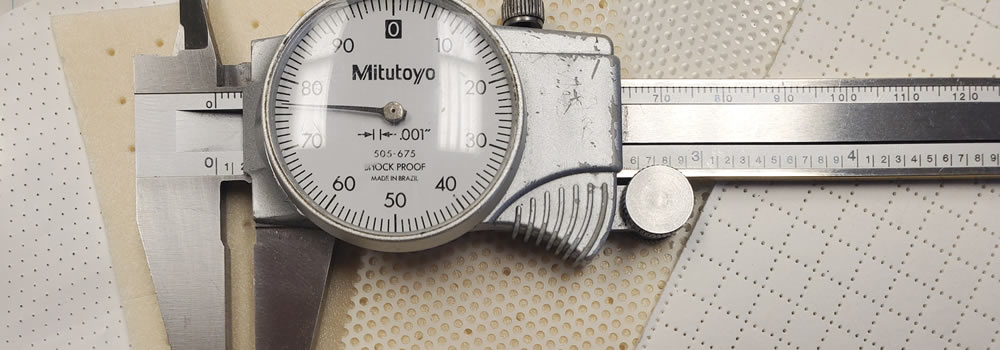
Perforation Types
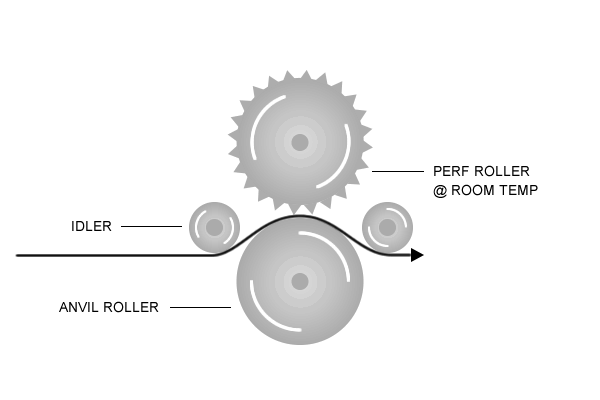
The least expensive and simplest way to add perforations to a material is with a mechanical perforation roller. The perforating tips push against an (anvil roller) to create required holes. High speed, cold perforation will typically run at the same speed as the machinery line it is incorporated into. Cold perforating can be added to just about any application, and can utilize pins or blades for slit or crush slit perforating. The holes created by pins are typically volcanic / funnel shaped, which can be an advantage in many applications. The pin tips can also be rounded or flattened to create embossing in the material rather than perforations. Stewarts of America also offer carousel or easy-change systems to allow the operator to change between hole patterns and types without having to remove any tooling from the perf unit.
Contact us for more info on Cold Pin Rotary Perforation
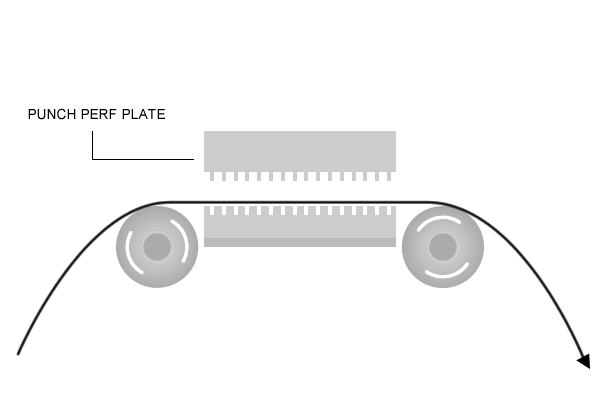
Need an aesthetic, clean, open hole? Punch perforating may be your answer. A male, flat, sharp edged pin pushes against a female hole to shear out the "chad" in the hole, while the material is indexed accordingly. The chad is removed by vacuum system and collected. Hanging chads percentages can be lowered by suction and sticky rolls downstream of the perforating unit. Punch perf is ideal for applications that require a high level of porosity. Punch perforators can be added to existing machinery lines, but are more commonly used in offline processes, as their production speeds can be a hinderance. The chads created by the punching action can be collected and used in other applications such as confetti, packaging media or for recycling processes.
Contact us for more info on Die Punch Perforation
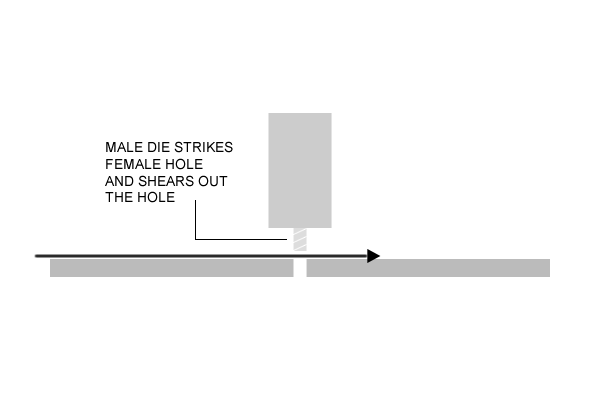
These perforating punching heads can be used as a single, hammer style unit, or can be ganged together, in multiple lanes and controlled by a Stewarts of America touchscreen system to control the punch firing and create many different hole patterns. The male pin and female die are forced together by an electronically controlled solenoid at incredibly fast speed. So fast, that a continuous, fast-moving web can be punch perforated with a clean, open hole. Moving web electro-pneumatic or electro-mechanical punches can be easily fitted as an accessory to an existing process. The chads created by the punching action can be collected and used in other applications such as confetti, packaging media or for recycling processes.
Contact us for more info on Electro Pneumatic Perforation
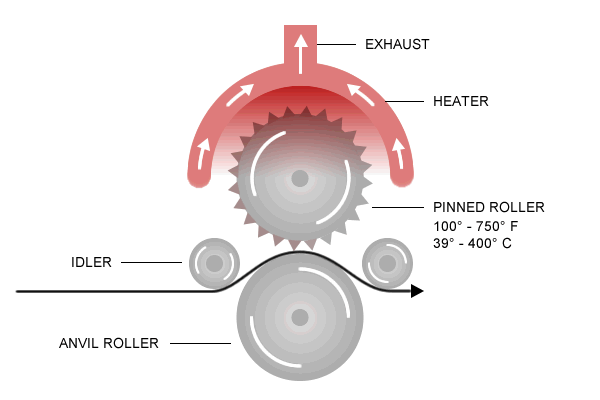
Working in a similar fashion to cold pin rotary, but controllable heat is introduced to the pin to melt or cauterize a hole in the material being perforated. The sharp pin is pushed against a suitable anvil roller, and the welt created around the melted hole serves as re-enforcement to the film. Stewarts of America hot needle perforating equipment is designed to work with the thermodynamics associated with hot needle perforating, and are designed to obtain the maximum efficiency from an energy consumption and process speed standpoint. Hot rotary perf can be added to many existing machinery line processes, and offers the benefit of a "laser like" hole without the added cost. Stewarts of America also offer carousel or easy-change systems to allow the operator to change between one hole pattern and size to another without having to remove any tooling from the perf unit.
Contact us for more info on Hot Pin Rotary Perforation
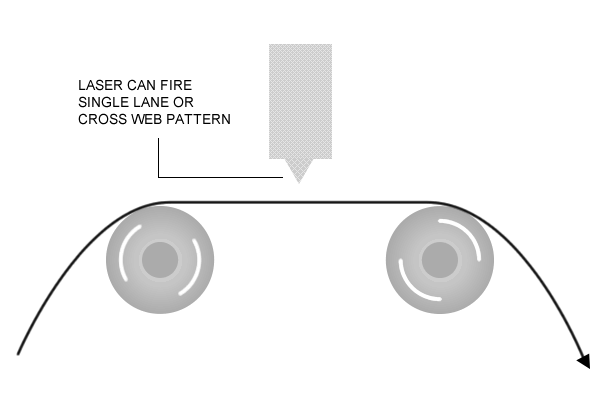
If your application requires holes that are on the nano scale (<100µ Ø) and flexibility is key, then laser perforation may be suitable for your application. Lasers can be cost restrictive, so it is important to determine whether the benefit of a laser made hole is paramount to your application. Lasers are especially effective on sensitive materials where mechanical contact may be an issue. It can be the ideal technology for applications requiring a precise but relatively low level of porosity. They can be also used for scoring rather than hole making. Lasers can be added to existing equipment or can be utilized as an offline process.
Contact us for more info on Laser Perforation
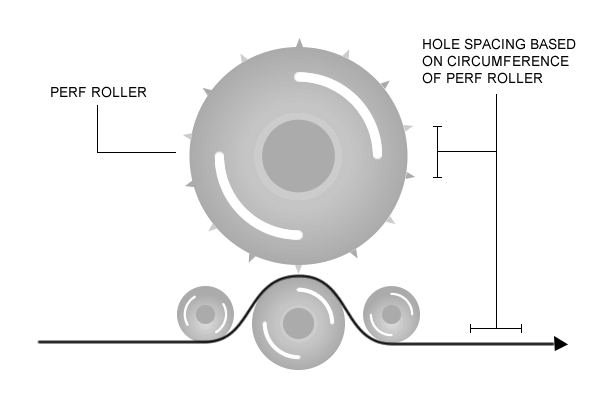
If your application calls for a hole or a tear line in a repeated place, we can create the repeat mechanically, based on dividing the circumference of the roller as required. The perforating unit can be either belt driven off the web, or driven by electrical motor and speed matched. This method of perforation is especially useful in high speed application such as paper, tissue or nonwoven tear off lines. If blades are used, we can design the blades to work with the specific material to be perforated. Cross tear lines can be altered in slit width and tie width as required, so the material integrity post perforation can be controlled to work with the tension controls.
Contact us for more info on Mechanical Register Perforation
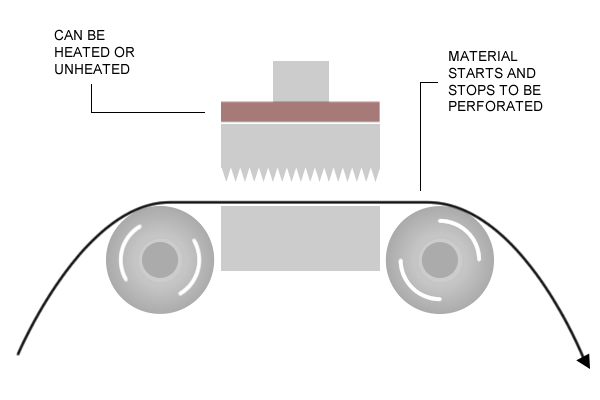
This technology combines vertical punching with pin or slit perforation. The pins/blades are pushed against an anvil pad that can be made from a verity of materials, depending on the application and material being perforated. The material must be paused momentarily for the perforating unit to punch the holes. These units are often used on bagging lines after a dancer, as the indexing action already exists.
Contact us for more info on Punch Perforation
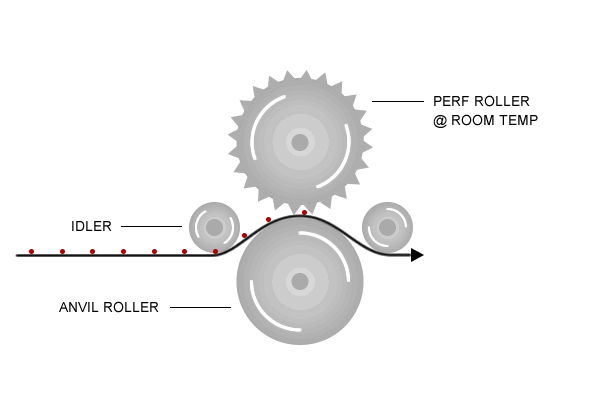
This method of perforation takes registered perforations to a higher level. Servo driven and precision touch screen controlled, the technology can either repeat a perforated position, or look for a color mark/registration mark and perforate where required. The perforating unit monitors the speed of the web, and will advance or retard the roller speed while the perforating pin/blade is not engaged. The unit will then speed-match the web while the perforation is placed in the appropriate location.
Contact us for more info on Registered Rotary Perforation
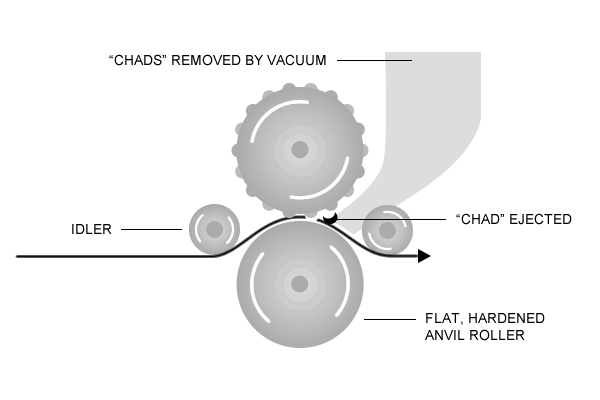
Hollow pins with specially designed internal ejection pins shear the material against a hardened anvil roller and then ejects the chad into a vacuum collection system. Typically used with few, larger holes, rotary die ejection perforating allows you to cleanly punch perforate at speed. The chads created by the punching action can be collected and used in other applications such as confetti, packaging media or for recycling processes.
Contact us for more info on Rotary Die Ejection Pin Perforation
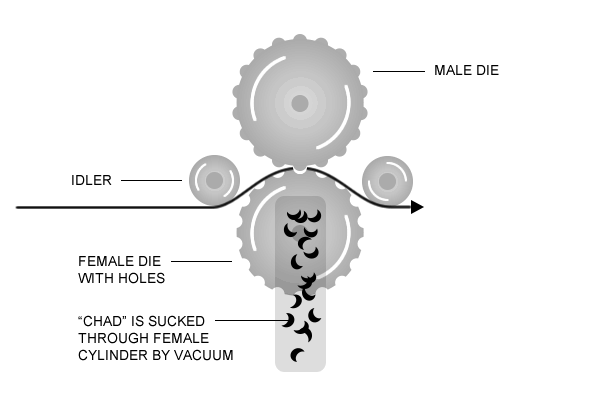
Similar to rotary ejection, rotary die uses a male shearing pin against a female die hole. This precision set of rolls run together to shear out the chad and leave a clean, open hole. The difference is that chads are sucked though the center of the female roller and are collected by vacuum. Rotary dies are typically added to existing machinery lines and are often used alongside rotary die cutting stations. The chads created by the punching action can be collected and used in other applications such as confetti, packaging media or for recycling processes.
Contact us for more info on Rotary Die Perforation
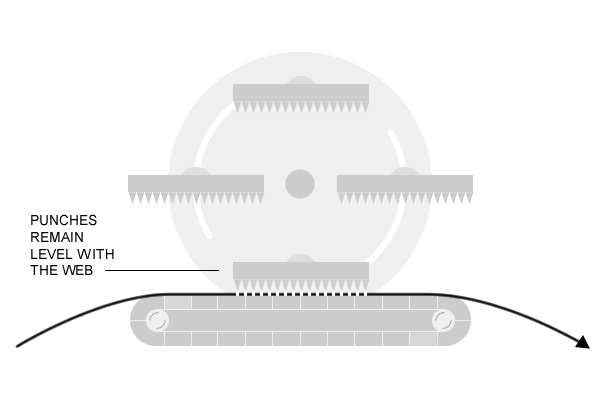
Easy open tear lines, open tear designs with blades or with pins can be incorporated into this design. The flat perforating plates are mounted on a center rotating carousel that is servo controlled. The design makes the perforating place to remain parallel to the film being processed that is run over a moving anvil. The servo unit speed matches the rotation of the carousel to the web when perforating, and can advance or retard the speed as required to create various repeats. This design has the advantage of being able to perforate easy tear lines for beverage bottles and cans, price tags, stamps, and other applications.
Contact us for more info on Rotary Flat Punch Perforation
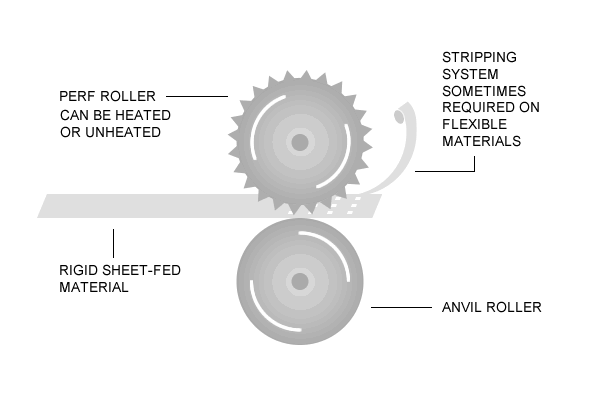
If your application involves a material that is in sheet form, or a rigid material such as OSB board, laminate board, open cell or closed cell foam or sheetrock/gypsum board, this method of perforation is your solution. The pins can be left cold or heated as required, the sheet fed unit processes the rigid material straight thought he machine. A stripping system can be incorporated for more challenging materials that like to stick to the perforating pins.
Contact us for more info on Sheet-Fed Rotary Perforation
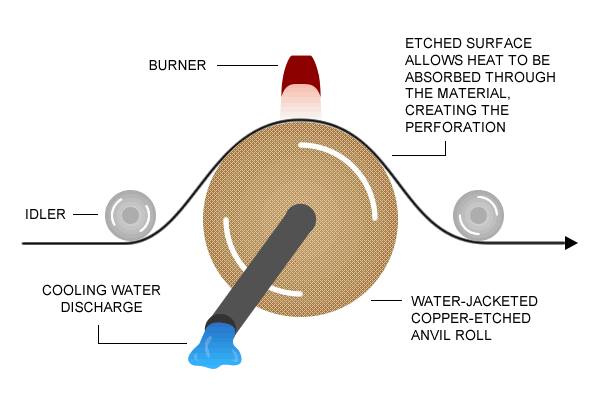
This method of perforation utilizes an etched copper drum that is water filled. A burner is angled and blazed over the material as it runs. The area of the perforating roller that is unetched conducts the heat thought the material and creates the perforation. The etched part of the roller creates an air pocket that acts as an insulator, preventing that part of the film being perforated. Up to a 30% open area can be created on select materials, and hole diameter capabilities typically range between 250µ-1500µ in Ø. This technology requires the material to be bi-axially orientated, such as BOPE, BON, BOPP or BoPET.
Contact us for more info on Thermal Perforation
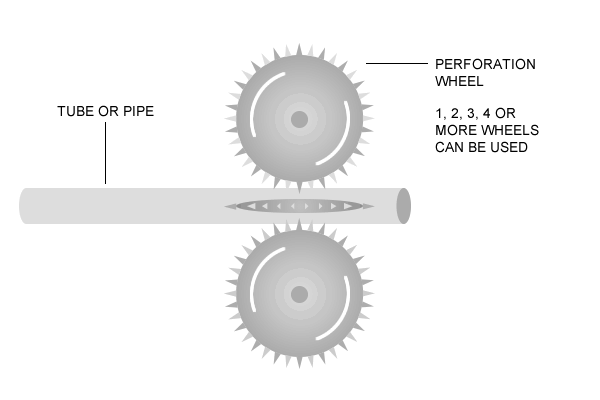
Hose, tube and pipe can all be perforated in a number of methods. Stewarts of America design a number of solutions for perforating cylindrical objects to include hand tools, offline machinery and inline machinery. Multiple pinned perf wheels can be mounted around the circumference if required. Machines can be benchtop or fully industrial grade and integrated, hand operated or completely automated with electrical motors, drives and sensors.
Contact us for more info on Tube Perforation
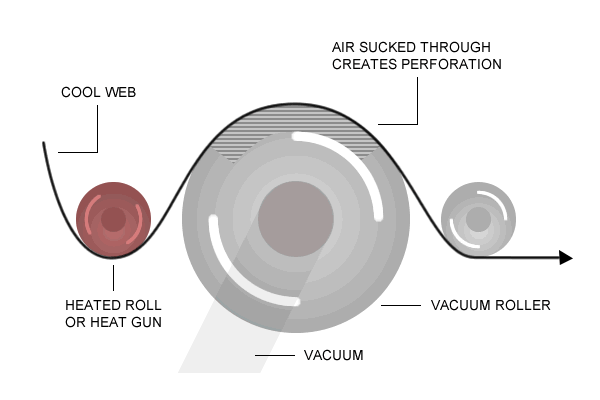
Uses a cylinder with air drawn though it to create the perforations in the web. The web is often run warm, directly from an extruder, or made warm with a heated roller or heat blower to make the material more malleable. The holes created are often quite volcanic. The 3D shape of the hole benefits from the openness of a hot perforation with the volcanic shape of a cold perforated hole.
Contact us for more info on Vacuum Perforation